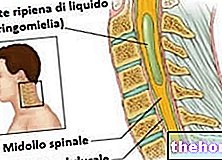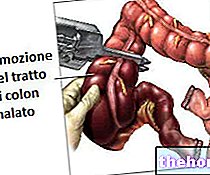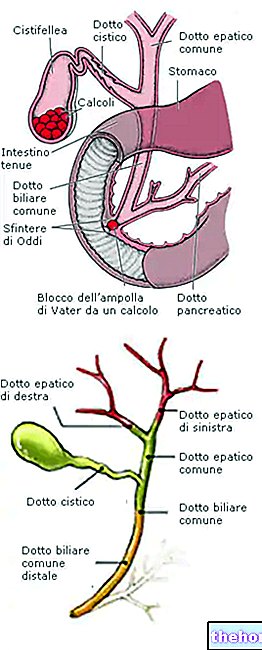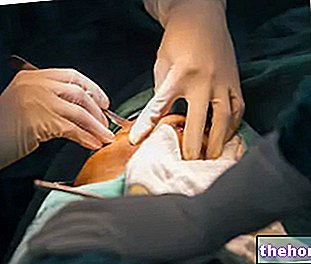Generality
Myomectomy is the surgical operation with which uterine fibroids are removed. This surgery is considered when uterine fibroids are symptomatic and annoying.
Preparing for myomectomy is very simple; moreover, if the doctor's instructions are strictly followed, complications are rare.

Figure: Types of uterine fibroid
There are essentially three surgical techniques that doctors can use: laparoscopy, laparotomy and hysteroscopy.
The results are satisfactory, although there is a risk of a relapse.
What is myomectomy?
Myomectomy is a surgical procedure aimed at removing uterine fibroids.
A uterine fibroid (otherwise known as leiomyoma or uterine myoma) is a benign tumor of the uterus, which can form on the inner or outer side of the organ.
N.B: a benign tumor is an abnormal mass of proliferating cells which, unlike what happens in malignant tumor, is neither infiltrating nor metastasizing (i.e. it does not metastasize).
MAIN CHARACTERISTICS OF UTERINE FIBROMES
Uterine fibroids are considered to be the most common tumors of the uterus. Nodule-like, they are made up of a small number of muscle cells and a large amount of fibrous tissue.
The size of the fibroids are extremely variable: in fact, there are fibroids in the uterus of a few millimeters and fibroids in the uterus as large as 20 centimeters.
The appearance of one or, more often, a series of uterine fibroids alters the structure of the uterus and reduces its contractile capacity (the loss of muscle contractility is a natural consequence of the greater presence of fibrous tissue).
Uterine fibroids can be asymptomatic (i.e. do not cause any obvious symptoms) or cause:
- Heavy menstruation and longer menstrual cycle
- Anemia due to more abundant menstruation (N.B: pathological lack of hemoglobin is called anemia)
- Pain and discomfort in the pelvic area
- Abdominal swelling and a feeling of heaviness in the lower abdomen
- Constipation
- Pain on urination
- Pain during sexual intercourse
- Reduced fertility and increased chance of miscarriages
When you do
Myomectomy is performed when uterine fibroids are symptomatic (that is, they cause one or more symptoms) and do not allow the affected woman to lead a normal life. Specifically, the situations for which the removal of uterine fibroids is most required are:
- A condition of persistent anemia and unresponsive to any alternative treatment.
- The presence of pain or a sense of heaviness in the lower abdomen that is continuous and cannot be relieved in any other way.
- An excessive difficulty in getting pregnant.
Myomectomy is preferable to hysterectomy (ie the complete removal of the uterus), because it preserves the uterus allowing the operated woman of childbearing age to have children in the future.
Risks
Myomectomy is safe. However, it's still surgery, so it's not completely risk-free. The best known complications are:
- Excessive bleeding (bleeding). The uterus is a highly vascularized organ and the appearance of fibroids further increases the number of blood vessels present. Therefore, a surgical incision made on a uterus in these conditions could lead to significant blood loss.
To prevent or reduce bleeding, surgeons often "pinch" the uterine arteries momentarily and inject coagulating drugs to slow the flow of blood to the point of operation. - Worsening of the state of anemia. It is due to excessive blood loss.
- Formation of scar tissue. The incisions and surgical sections envisaged by the intervention can lead to the formation of intra-abdominal adhesions (or adhesions). The latter are bands of fibrous tissue, which are created as a result of the healing process and which affect the normal anatomy of the organs interior.
- Increased risk of complications during post-surgery pregnancies. After myomectomy, the uterus becomes more fragile and, if pregnant, may rupture at the time of labor. To avoid this inconvenience, the doctor resorts to caesarean section.
- Need to have a hysterectomy. If the blood loss from the uterus is consistent and cannot be stopped in any way, the doctor may be forced to remove the uterus.
WHAT ARE THE USEFUL STRATEGIES TO AVOID SERIOUS BLOODING?
To limit blood loss and related effects (anemia), in view of a future myomectomy, the doctor may prescribe:
- A gonadotropin releasing hormone (Gn-RH) agonist or the contraceptive pill, to regulate the menstrual cycle and minimize the amount of blood lost with menstruation.
N.B: an agonist, in pharmacology, is a competitor of the natural molecule.
- A drug therapy capable of reducing the volume of uterine fibroids and of the uterus. In these conditions, the organ on which to intervene becomes smaller, just as the incision to be made becomes smaller.
The drugs used are, once again, the Gn-RH agonists; these, in fact, produce a sort of "temporary menopause": the patient, in fact, experiences hot flashes, night sweats, vaginal dryness, etc.
However, it must be specified that this drug therapy does not affect all women: in some, in fact, the fibroids take on an appearance indistinguishable from the rest of the uterus, so they are no longer recognized at the time of the operation.
Preparation
Myomectomy is a surgical procedure that involves general anesthesia or spinal anesthesia, therefore, before it can be performed, the woman to be operated on must be subjected to the following clinical checks:
- Thorough physical examination
- Complete blood test
- Evaluation of the clinical history (diseases suffered in the past, any allergies to anesthetic drugs, medicines taken at the time of checks, etc.)
- Electrocardiogram
If no contraindications of any kind emerge, the doctor explains to the patient everything that involves the operation, including pre- and post-operative recommendations, the type of anesthesia envisaged, the surgical technique used, the expected duration of the operation and the times recovery.
PRE- AND POST-OPERATIVE RECOMMENDATIONS
In order for the entire operation to proceed smoothly, the patient is required to:
- Before myomectomy, stop any drug intake based on antiplatelet drugs (aspirin), anticoagulants (warfarin) and anti-inflammatory drugs (NSAIDs); this interruption is necessary because these drugs, by reducing the clotting capacity of the blood, predispose to severe bleeding.
- On the day of myomectomy, go to complete fasting for at least the previous evening, as general anesthesia or spinal anesthesia is required.
- After the surgery, have a family member or friend accompany you home.
Procedure
Depending on the number, location and characteristics of uterine fibroids, the surgeon can perform myomectomy in laparotomy (abdominal or traditional myomectomy), in laparoscopy (laparoscopic myomectomy) or in hysteroscopy (hysteroscopic myomectomy).
ABDOMINAL MYOMECTOMY
Surgery performed in laparotomy involves opening the abdomen by making an incision of several centimeters in the belly, which makes the procedure invasive and the post-operative phase very long.

Figure: laparoscopic myomectomy. From the site: en.wikipedia.org
Abdominal myomectomy, which involves general anesthesia, is indicated for uteri covered with several large fibroids. The incision on the abdomen can be horizontal or vertical, depending on the location and characteristics of the fibroids.
After the procedure, the surgeon closes the patient's abdomen with sutures.
LAPAROSCOPIC MYOMECTOMY
Laparoscopy is a minimally invasive surgical technique, which allows you to operate without the practice of large skin incisions; the operation, in fact, involves two or three small incisions, which are used by the surgeon to introduce the laparoscope (an apparatus equipped with light and camera) and the surgical instruments.
Laparoscopic myomectomy, which requires general anesthesia, is suitable for uteri with up to two fibroids, and these must measure no more than 5-6 centimeters and be located on the outer wall of the uterus (subserosis).
Robotic myomectomy
Robotic myomectomy is a laparoscopic operation in which the surgeon, instead of operating himself, guides a robotic instrument equipped with mechanical arms, which, in fact, replace his hands. This allows a high precision of the intervention.
HYSTEROSCOPIC MYOMECTOMY
Hysteroscopic myomectomy is a minimally invasive surgical technique, which is performed by introducing a special instrument called a resectoscope into the uterus through the vagina and cervix.
The resectoscope, in addition to having a light and a camera connected to an external monitor, is equipped with a source of electrical discharges: these discharges are used by the surgeon to eliminate the tissue that constitutes uterine fibroids.
Hysteroscopic myomectomy is appropriate for medium to large uterine fibroids of the submucosal type. It can be performed under general anesthesia or spinal anesthesia.
IS IT POSSIBLE TO OPERATE IN PREGNANCY?
Pregnancy can stimulate the appearance of fibroids. These are generally removed some time after birth, but it may happen, on rare occasions, that they need to be removed shortly before the baby is born.
Post-operative phase
The post-operative phase depends on the type of intervention:
- Abdominal myomectomy: as this is a very invasive operation, it may require hospitalization for several days, even 3 or 4. Expected recovery time: 4-6 weeks.
- Laparoscopic myomectomy: requiring general anesthesia, requires the patient to spend at least one night in the hospital, for completely precautionary reasons. Estimated recovery times: 2-3 weeks.
- Hysteroscopic myomectomy: if performed under spinal anesthesia, the patient can be discharged a few hours after the operation. Recovery times are very short: one week, except for complications.
HOW LONG AFTER THE "INTERVENTION CAN" HAVE A PREGNANCY?
After a myomectomy, the uterus takes about 3 months to heal completely: doctors therefore recommend waiting at least 90 days before becoming pregnant.
Results
The results of myomectomy are quite satisfactory.
Very often, in fact, the symptoms caused by fibroids disappear and fertility increases. However, it is possible that after a few months relapses appear (i.e. the fibroids re-form) and that a second myomectomy operation is necessary.




























